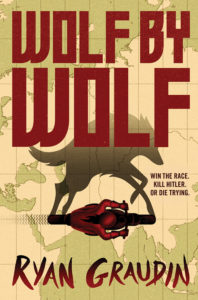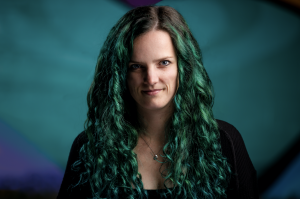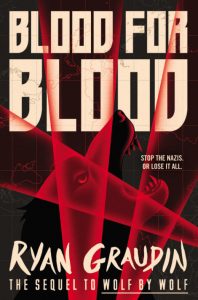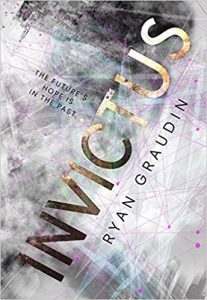Author Ryan Graudin discusses her YA duology Wolf by Wolf and Blood for Blood.
For her interview with Reading Group Choices, Graudin talks about the symbolism of wolves, championing the female “Hero’s Quest”, and what history teaches us about racism and injustice…
Reading Group Choices: Did you know from the outset that Wolf by Wolf would have a sequel? If so, why did you know you wanted it to be two books instead of one? And do you have plans to revisit the characters in a third volume?
Ryan Graudin: The books were sold to my publisher as a duology, so yes, I had the sequel in mind from the get go. I didn’t really consider it a sequel when I was plotting the series—more like the second volume of a story that was too big to fit in a single book. As for a third book, I often find myself missing Yael’s voice and while I know where she goes after Blood for Blood, I’m not sure it’s enough of a story to justify another novel. My motto for future projects is never say never though, so… we’ll just say a third installment is unlikely.
 RGC: The wolves are an important symbol in both books. How did you decide to use wolves?
RGC: The wolves are an important symbol in both books. How did you decide to use wolves?
Graudin: In most stories, wolves are painted as one-dimensional creatures: evil predators. And yes, it’s true that wolves hunt and kill, but if you take the time to study their behaviors, you’ll find that they’re affectionate creatures who form strong bonds with their pack members.
This duality resonated with me when I was drafting Wolf by Wolf. World War II has been well-mythologized, and I believe one of the reasons people are so fascinated with this historical conflict is because of how it frames humanity. Both the worst and best sides of our nature emerged during that era. Acts of unspeakable evil were carried out by Hitler and the SS, while others, such as Sophie Scholl, sacrificed their lives to protect people who could not protect themselves.
Wolves were Hitler’s favorite animal, mostly because of their “Big Bad Wolf” mythos. He lauded them as the “purer” warrior form of dog and took great pride in the fact that Adolf meant “noble wolf” in Old High German. Those in his innermost circle frequently called him ‘Wolf’ and one of Hitler’s Eastern front headquarters in Poland was named the Wolfsschanze (or Wolf’s Lair).
My choice to use wolves as a symbol for Yael’s pack—or the people from her past whose stories guide her forward—was an ode to the duality of human nature and free will. During times of conflict and crises, we can choose how we respond. Are we predators or pack members? Do we fight to destroy or do we fight to save? All of us have the capacity for both. It just depends on “which wolf we feed.” (To reference the two wolves inside of you legend.)
RGC: Names seem to hold important meanings and value for each character. How did you choose the characters’ names in the books?
Graudin: I’m a sucker for allusions. Yael’s name is a nod to Jael from the Book of Judges, a woman who saved the nation of Israel by driving a tent peg through an enemy general’s temple. Miriam and Aaron-Klaus are references to Moses’s siblings in the Book of Exodus.
I’m also a sucker for the meanings behind names. Löwe (Luka’s surname) means lion and Wolfe (Adele and Felix’s surnames) means… well, wolf. Geyer means vulture. The list goes on. I also try to find names that fit a character, sounding exactly the way I envision them in my head.
 RGC: The novels present a female undertaking a traditionally male journey. Was this intentional? Have you received responses from female readers who identify with the main character because of this role?
RGC: The novels present a female undertaking a traditionally male journey. Was this intentional? Have you received responses from female readers who identify with the main character because of this role?
Graudin: I’ve always been drawn to books where the “Hero’s Quest’’ features a heroine, so it never occurred to me to write anything else! As a young girl, I hungered for books that affirmed that I too could go on an adventure and have a story worth telling. I’ve certainly had a lot of feedback from readers who relate to Yael. Many of them are female, but what I find interesting is that Wolf by Wolf has become a book that teachers and librarians offer to “reluctant readers” (who are, more often than not, teenage boys). It’s the motorcycle race—the traditional male journey—that draws these boys in, but as they keep reading, they too find themselves relating to Yael.
Obviously, this thrills me! Female-centric narratives deserve a wide readership—a small, but important step in addressing misogyny and sexism.
RGC: How did you begin to tackle the historical research for the book? Did you already have a pretty robust knowledge about the Axis powers and World War II, or was a lot of the information and detail new to you when you started writing the books? Was there anything in particular that was a surprise or shock for you to learn?
Graudin: Thanks to a father who loves history, years of independent reading, and college courses, I had a good baseline knowledge of World War II. But creating this alternate history took a much deeper dive into how the Nazi party operated. I started by reading William L. Shirer’s The Rise and Fall of the Third Reich from cover to cover. It’s an incredibly thorough account, beginning before Adolf Hitler’s birth and ending with a detailed account of Hitler’s vision for the world, had he won the war. This was a good springboard for the rest of my research, which spanned everything from books and documentaries to shooting WWII pistols at a gun range.
I love writing stories based on history, because the past is, more often than not, stranger than fiction. For example, did you know that the Volkswagen Beetle was the brainchild of Adolf Hitler? Yep. The car we associate with peace and love and hippies was designed by the leader of the Third Reich. He wanted a “people’s car” (which is the literal translation of Volkswagen), and personally helped produce the Beetle.
 RGC: Along with your historical research, did you also spend a lot of time researching motorcycles? Is there a specific connection you have with motorcycles? How did you choose the specific motorcycle for the race?
RGC: Along with your historical research, did you also spend a lot of time researching motorcycles? Is there a specific connection you have with motorcycles? How did you choose the specific motorcycle for the race?
Graudin: One of the inspirations for Wolf by Wolf was Long Way Round, a BBC miniseries documentary that follows Ewan McGregor and his friend Charley Boorman on a motorcycle journey from London to New York via the Road of Bones in Siberia. This trip is vast and beautiful and, at times, harrowing. The road is filled with mud pits, river crossings, navigational issues, and encounters with strangers. There’s so much that could go wrong! Watching it, I thought to myself, this would be a great concept for a YA novel.
Motorcycles also fit into Wolf by Wolf’s historical context. There was an entire branch of Hitler Youth devoted to riding and caring for motorcycles (the Motor-Hitlerjugend or Motor-HJ) and given Joseph Goebbels’s love of propaganda and fanfare, a competition like the Axis Tour isn’t actually that far-fetched.
When I was writing the first draft, my husband and I visited a dirt-biking park in the middle of South Carolina. Having never operated a motorbike before, I went from knowing absolutely nothing to zooming through forests and sand pits in a day! It gave me a taste of what I was putting Yael through…bruises and scrapes and burns and eventual saddle-soreness!
RGC: Many characters in the book take great personal risk to help the main character. Can you talk about what compels people to take such risks? Who have been your own helpers and mentors?
Graudin: I think this question ties back to my thoughts about the duality of human nature, and how—in a time of crises—some people react destructively while others act selflessly. Which way someone goes, I believe, is the result of “which wolf” that person has “fed” throughout their lives. The good or the evil. This is why I seeded in Yael’s backstory the way I did: it helps readers understand why she’s making her present choices.
As for my own mentors—my parents have been a big one. My mother, especially, took great pains to raise me as a critical thinker. She took me to the library every week to instill a love of reading, she worked extra hospital shifts to ensure I had the best possible education, and she kept working these shifts even when she decided to homeschool me for a few years. Her work ethic and compassion made me the writer I am today.
I also have to give teachers their due credit. Throughout my years in school, I had countless educators who went the extra mile to help me think critically and hone my creative voice.
Teachers and parents have some of the hardest, most rewarding jobs in the world. Children are impressionable. They mirror the behavior they see around them. As a new-ish parent myself, I want to help my daughter “feed” the “good wolf.” I want her to grow up to be a compassionate, creative critical thinker.
And so the cycle goes…
 RGC: Loss is such a large part of the book, as it is such a large part of growing up. What loss was the hardest for you to write about? Was loss something you struggled to accept growing up?
RGC: Loss is such a large part of the book, as it is such a large part of growing up. What loss was the hardest for you to write about? Was loss something you struggled to accept growing up?
Graudin: As a child, I hated change: moving houses, switching schools, saying goodbye to friends.
All of this paled by comparison when my mother was diagnosed with Grade 4 Astrocytoma, a brain tumor that had a very low survival rate. I was eighteen when she first got sick, and even though she went into remission after several surgeries, radiation, and chemotherapy, the fallout from these treatments caused almost more damage than the tumor itself. Over the next fourteen years my mom experienced a slow loss of mobility and language, among other things. Walking this path with her and trying to navigate the strange grief of losing your mother without having actually lost her yet, was something from that informed one of the flashbacks in Wolf By Wolf. Yael’s (brief) estrangement from her mother before she dies was told through this lens.
In hindsight, that’s probably what made the scene such a tough one to write.
RGC: What draws you to the idea of “what could have been,” both in writing and in life?
Graudin: Studying history, traveling the globe, and trying to see hints of magic in everyday life have been my biggest inspirations. The what if question helps me take the ingredients I gather on these ventures and grow them into a book-sized idea. I think it’s also a natural side effect of being a perpetual day dreamer. I’ve never not thought this way, and I feel incredibly grateful that I’ve found a job where I can capitalize on this!
RGC: The skinshifts allow Yael to take on other’s appearances, and highlights ideas of racial identity and superiority. It challenges the reader to think about how we may judge others, and how society judges on the basis of physical appearances and race still today. What do you hope readers take away or understand about racism after they’ve read the books? What action do you wish they would take upon reading?
Graudin: I hope they read more. Wolf by Wolf was always intended to serve as a gateway book, to draw in reluctant readers and transform history for those who’ve found the subject boring. This is a sentiment I hear a lot, unfortunately, and it’s understandable if you’ve only been exposed to lackluster teachers and textbooks.
History is full of lessons. Ones humanity has been slow to learn. Racism has plagued our society for a very long time, and it’s important for us to understand just how pervasive it is—how systems we’ve come to accept as default are actually grown out of intense prejudice and injustice. To begin uprooting them, we have to understand how deep they go. We also need to approach this work with open hearts. Hearts that are willing to listen and learn. Hearts seeded with empathy and cultivated by education.
 Obviously, reading is a key component to this. Reading history especially. We need to understand where we’ve been to inform where we’re going. I hope Wolf by Wolf introduces young readers to the true history of World War II and the Holocaust. I hope this, in turn, ignites a love of learning. I hope my readers keep their hearts soft and their minds sharp. I hope they find themselves brave enough to face our broken world and compassionate enough to change it.
Obviously, reading is a key component to this. Reading history especially. We need to understand where we’ve been to inform where we’re going. I hope Wolf by Wolf introduces young readers to the true history of World War II and the Holocaust. I hope this, in turn, ignites a love of learning. I hope my readers keep their hearts soft and their minds sharp. I hope they find themselves brave enough to face our broken world and compassionate enough to change it.
RGC: Have you been working on anything recently, and can you tell us about your next project?
Graudin: My next book is a middle-grade novel called The World Between Blinks, co-authored with Amie Kaufman. It’s slated to hit shelves on January 5th 2021. Here’s a small teaser:
The World Between Blinks follows two cousins who stumble from our world into a magical place where all lost things end up. Amid ghost ships, lost cities, and keys to vanished doors, Jake and Marisol find themselves responsible for the fate of not just one world—but two.
As for more YA novels, I’ve been hard at work crafting things that involve lots of twisty history, but there’s no official word on anything yet. One of the best ways to stay in the loop about my upcoming releases is to follow me on Twitter or sign up for my newsletter.
Looking for more? Check out all of the great author interviews on our blog, including other YA authors like Avi and Anne Nesbet!
